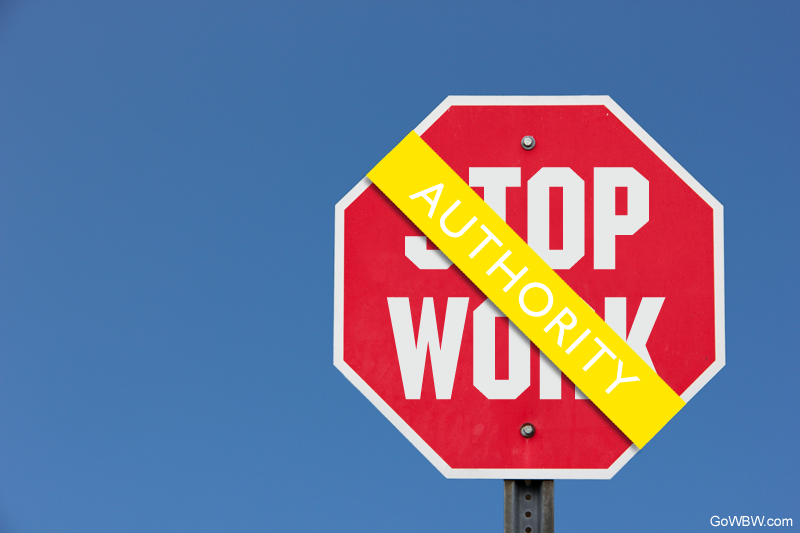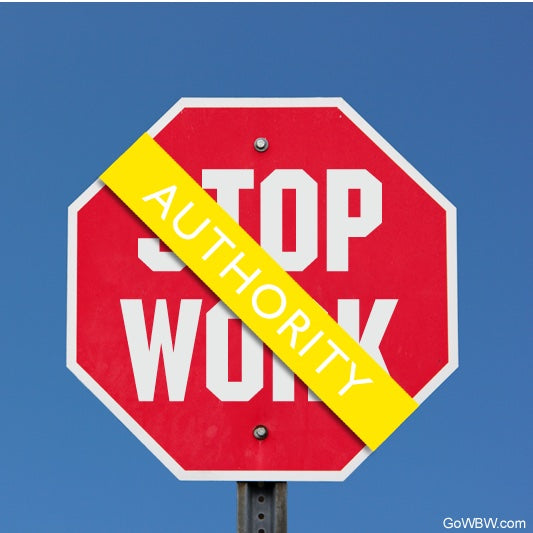
What is Stop Work Authority (SWA)?
Stop Work Authority (SWA) is a program designed to provide employees and contract workers with the responsibility and obligation to stop work when a perceived unsafe condition or behavior may result in an unwanted event. A key element of a Stop Work Authority Program is a detailed set of written procedures. They will help ensure that every SWA event works consistently and as intended.
Stop Work Authority Roles and Responsibilities
A Stop Work Authoring program must clearly define the roles and responsibilities. Examples of roles and responsibilities are:
- Senior Management: Creates a culture that promotes SWA, establishes clear expectations and responsibilities. Demonstrates support for using SWA without the potential for retribution. Resolves SWA conflicts when they arise. Holds employees and contractors accountable for full compliance with the SWA program.
- Supervisors and Managers: Promotes a culture where SWA is freely exercised, SWA requests are honored and resolved before resuming operations. Ensures necessary stop work follow-up is completed.
- HSE Department: Provides training, support, documentation and monitors compliance of the SWA program.
- Company employees and contractors: Initiate stop work (in good faith) and support stop work initiated by others.
Situations that may Require a Stop Work Action
Stop Work Authority should be initiated for conditions or behaviors that threaten danger or imminent danger to person(s), equipment or the environment. Situations that warrant a SWA may include, but are not limited to the following:
- Alarms
- Change in conditions
- Changes to scope of work or work plan
- Emergency situation
- Equipment used improperly
- Lack of knowledge, understanding or information
- Near-miss incident
- Unsafe conditions
Stop Work Authority Process (6 Step Example)
Stop Work Authority is a several step process - stop, notify, investigate, correct, resume and follow-up (training on lessons learned etc.)

1. Stop
When an employee or contractor perceives condition(s) or behavior(s) that pose imminent danger to person(s), equipment or environment he or she must immediately initiate a stop work intervention with the person(s) potentially at risk.
If the supervisor is readily available and the affected person(s), equipment or environment is not in imminent danger, coordinate the stop work action through the supervisor. The stop work action should be clearly identify as a stop work action and initiated in a non-combative manner.
2. Notify
Notify affected personnel and supervision of the stop work action. If necessary, stop work activities that are associated with the work area in question. Make the area(s) as safe as possible by removing personnel and stabilizing the situation.
3. Investigate
Affected personnel will discuss the situation and come to an agreement on the stop work action.
If all parties come to an agreement the condition or behavior is safe to proceed without modifications, (e.g. the initiator was unaware of certain information or circumstances), the affected persons should show appreciation to the SWA initiator for their concern and then resume work. The SWA is complete at this point and no further steps are needed.
If it is determined and agreed the SWA is valid, A Stop Work Issuance Form will be completed. The condition(s) or behavior(s) that pose threats or imminent danger to person(s), equipment or the environment must be resolved before restarting work. Work will be suspended until a proper resolution is achieved.
4. Correct
Modifications to the affected area(s) will be made according to the corrections outlined in the Stop Work Issuance Form. The affected area(s) will then be inspected by qualified experts to verify completeness of the modifications and to verify all safety issues have been properly resolved. The completion of modifications will then be noted on the Stop Work Issuance Form.
5. Resume
The affected area(s) will be reopened for work by personnel with restart authority. All affected employees and contractors will be notified of what corrective actions were implemented and that work will recommence.
In the event an employee still believes it is unsafe, they will be assigned to another job with absolutely no retribution.
6. Follow-Up
Operations Managers will provide the root cause analysis to the stop work action and identify any potential opportunities for improvement. The Safety Manager will publish the incident details regarding the stop work action to all Operations Managers and employees outlining the issue, corrective action and lessons learned. Management will promptly review all stop work reports in order to identify any additional investigation or required follow-up.
Depending on your company and reporting structure your specific procedure may vary.
Stop Work Authority Conflict Resolution
It is important to have a defined process for conflict resolution in case opinions differ in regards to the validity of a stop work action, corrective actions or the decision to resume work. All opinions should be noted, however, a clearly defined protocol must be included in the Stop Work Authority Program to provide prompt conflict resolution. Persons with proper authority to make the final determination may include senior management and HSE managers who are not associated with the conflict.
Training
The importance of initial and ongoing training should not be underestimated. Implementing a Stop Work Authority Program that is understood by all personnel is paramount to ensuring success.
Tracking
Tracking SWA occurrences helps with the evaluation of the effectiveness of the program and identifies areas for improvement.
Retribution
It must also be noted that no retribution will follow a stop work action initiated in good faith even if it is deemed unnecessary. Personnel must not feel apprehensive to act on their obligation to initiate a stop work action.
Regulatory Requirements
Although Stop Work Authority Programs are not a required element of OSHA’s regulations, they are encouraged in OSHA’s Voluntary Protection Programs (VPP)(1). The United States Department of Energy has recognized SWA as a necessary element of their “Worker Safety and Health Program” Rule (10 CFR 851.20[b][9])(2), and the United States Nuclear Regulatory Commission discusses SWA in their “Safety Culture Common Language” NUREG-2165(3) reference material.
Forward from:
https://blog.ehssoftware.io/safetyinsiderblog/how-to-establish-an-effective-stop-work-authority-program










